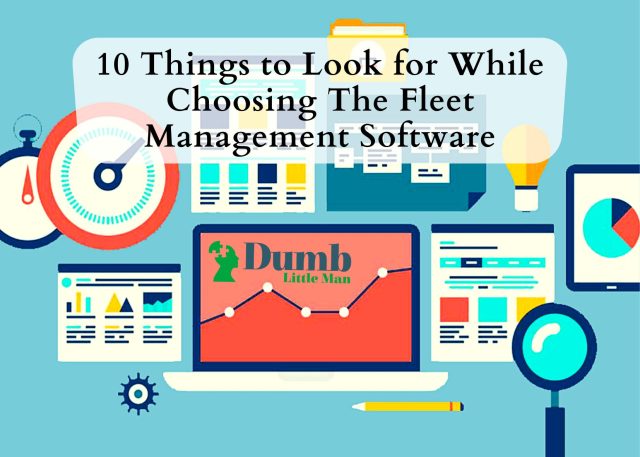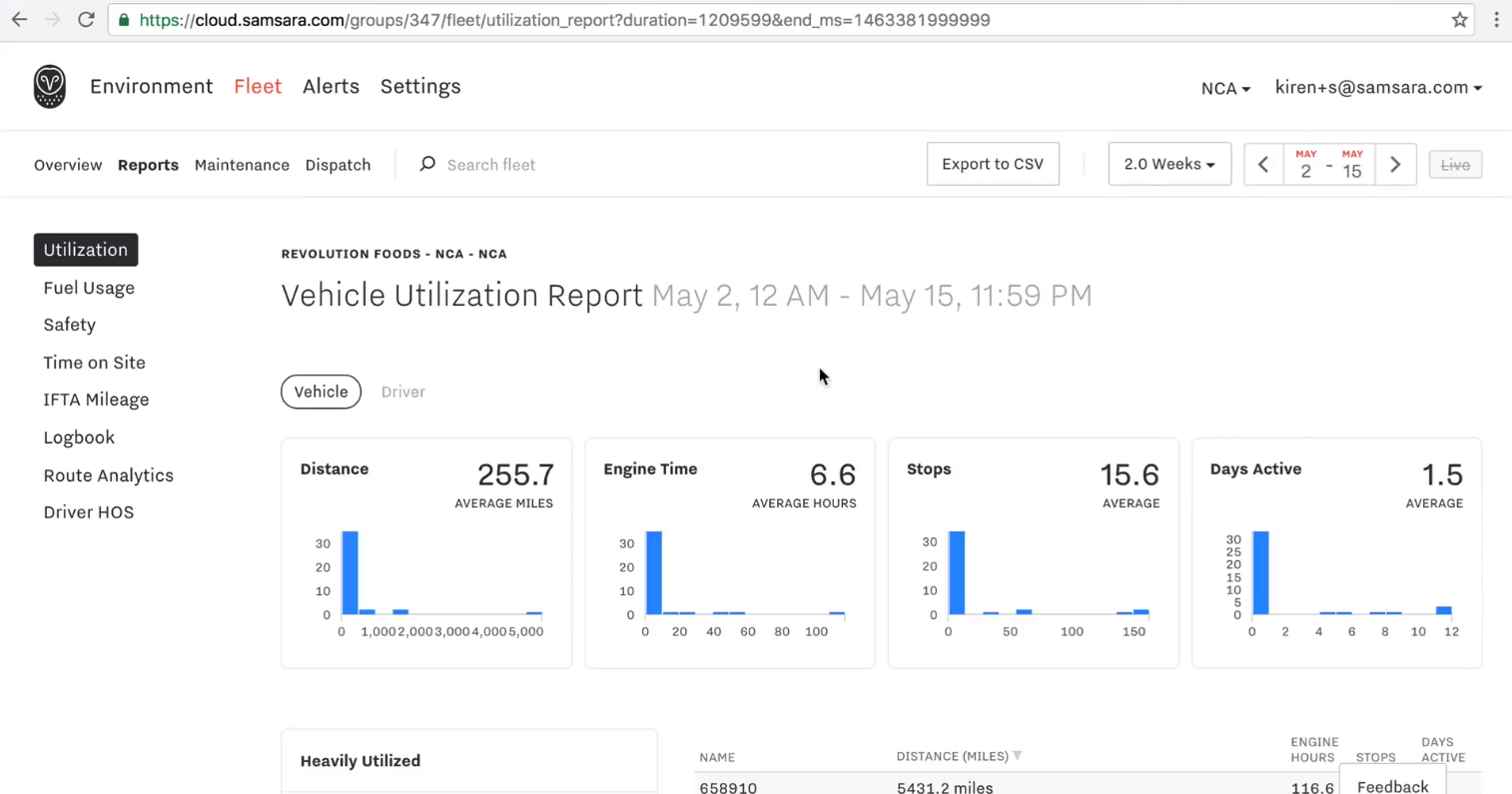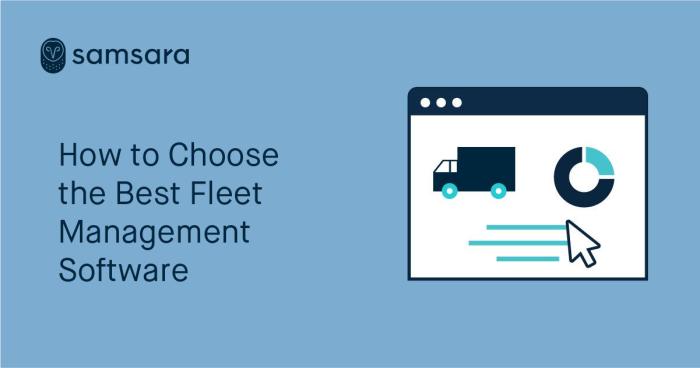10 Things to Look for While Choosing The Fleet Management Software
By Dumb Little Man
January 10, 2024

Choosing the best fleet management software which manages your fleet requires some research to identify options that are according to meet your company's needs. With knowledge of which things to look for when choosing the best fleet management software, such as key features that will make your job easier, you can quickly find software that helps to improve the efficiency of handling your fleet.
What is a Fleet Management System?
The fleet management system has completely transformed over the last decade as businesses start to see the impact that an efficient fleet can have on business operations. It now working on much more than procuring and maintaining vehicles, and fleet management teams are now responsible for a wide range of activities including driver management, compliance management, operational efficiency, and impact on the environment.

Importance of Fleet Management System
A fleet management system can help by giving you access to clear and informational data about the vehicles across your entire fleet. A fleet management solution is software that provides data-based insights about GPS vehicle tracking, Hours of Service (HOS) compliance, safety, upcoming vehicle maintenance, protection, and more. The software is designed according to requirements to ease the burden on the fleet manager's shoulders—helping to reduce costs, streamline workflows, and automate more processes within your fleet operations.

Using digital data through a fleet management program prevents loss of paperwork/money or human error in misinterpreting paper records. The transfer to digital record-keeping already applies to many commercial vehicles on the road. For example, many transport trucks and commercial buses use electronic logging devices (ELDs), per the Federal Motor Carrier Safety Administration (FMCSA).
One way that these devices can be used for managing a fleet is through the information they gather. Electrical logging devices collect information about records of duty status (RODS) for use in safety audits or during investigations. The electronic information collected includes the hours of service (HOS) for the driver. A fleet manager can gather this information and ensure its accuracy to optimize scheduling to avoid over-or underworking drivers. Solutions that connect electrical logging devices to a cloud platform also allow fleet managers to check a driver's status at any time from a computer, tablet, or mobile phone.
Comparing Fleet Management Software
There is a huge difference between fleet management software. When it comes to fleet management software, essential features should be configurable to fit your fleet’s needs. Keep in mind, not all software is created equal and has different working.
You may come across many different providers offering a similar solution, but the capabilities might differ greatly. This stresses the essence of conducting a trial or demo of the fleet management software before committing to it.
Taking a hands-on approach with a trial or demo free ensures you know how the features work and how they can be implemented across your operation.
What Features Should a Fleet Management Software Have?
There are a lot of fleet management software providers available to choose from. Many fleet management systems don’t offer enough features to manage the most important data related to your fleet in just a single software.
The best fleet management software centralizes all your data, integrates with other solutions, automated workflows, and maintains a comprehensive database making life much easier for fleet managers.
When deciding on a fleet management solution, it is important that it offers advantageous features and capabilities to help you manage every aspect of your operation in less time.
1. Ease of Use
Some fleet managers can be anxious when making the switch to an improved fleet management system due to poor working. Fortunately, fleet management software is intuitive, offers a variety of unique features, and is configurable to your fleet.
One of the best ways to start using your fleet management software is by dimension importing your vehicle identification numbers (VINs) into a VIN Decoder. This allows you to instantly retrieve over 90 specifications on each of your accounts. From there, you can begin using the features that matter, like completing a vehicle inspection or managing your maintenance workflow.
Though most fleet management systems seem easy to use, there are often questions along the way. A quality fleet management software should offer a strong support team and robust training resources for you to troubleshoot any issues without delay.
2. Simple Implementation
One of the advantages of implementing a web-based fleet management solution, like Fleetio, is that you can easily start using the product easily, as there’s no on-site implementation. As soon as an account is created, sign up and onboarding are a breeze.
While fleet managers can get started on their own, quality fleet management software provides live support and educational resources, like training videos and webinars, to guide you through implementation. Fleetio also provides Professional Services Packages to accelerate the onboarding process and offers much feature-based training.
3. Mobility
Your fleet is mobile and your fleet management system should be installed on mobile. The use of outdated paper processes inhibits communication and doesn’t give a clear look at your fleet in real-time. The ability to collaborate through software and mobile apps in real-time can transform your fleet efficiencies. A fleet management solution that prioritizes visibility and collaboration allows you to enact the most proactive approach.
A mobile-first fleet management software enables fleet managers to stay connected to drivers, maintenance supervisors, mechanics, and their assets with a native mobile app. The use of an application to work on fleet management tasks enables users to log and upload accurate data instantly, keep the lines of communication open and maintain vehicle uptime.
4. Scalability
All fleets are different and range according to size. Whether you have 5 or 50,000 mobile assets, the best fleet management software is scalable and caters to your fleet’s specific needs.
Scalable fleet management software, like Fleetio, provides simple pricing based on the number of assets in your fleet. This pricing model enables fleet managers to pay for what they need, determine what plan’s features work best for them, and easily scale as their business grows.
5. Integration Options
Many fleets, even ones not currently using fleet management systems, currently use some form of technology to streamline processes. Tools like telematics devices and fuel cards aid fleet management and offer large amounts of data to track and analyze.
While these tools are useful on their own, combining them with fleet management software augments value by allowing you to track all fleet data in one place. Fleetio not only integrates with many of the top telematics devices and fuel cards but also offers Maintenance Shop Integration, allowing you to manage external repair orders and consolidate your billing.
6. Reporting
The secret to the success of your fleet is all in the numbers. Having hard data on different aspects of your fleet helps you make the best choice for maintenance and operations.
While spreadsheets may have the data, they can be difficult to surface, read, and analyze quickly safely. Instead of tracking down the right information to send to stakeholders, fleet management software offers robust reporting capabilities for you to analyze and improve your fleet.
In addition to having easy-to-read data at your fingertips, a fleet management system allows for flexible, configurable reporting for you to get the most out of your data. You can also subscribe to reports you need regularly, or export them to PDFs to share with other stakeholders.
7. Expense Management
A fleet manager can spend hours, days, even months crunching numbers to try and determine their fleet’s true total cost of ownership (TCO). What if this was automatically calculated and he saved money and time?
To get a true look at your TCO and vehicle cost per mile, a fleet management system provides comprehensive expense reporting that offers a detailed look at your operating costs. Not only does this allow you to gain insight into expenses, like fuel and maintenance, but it also helps identify overspending and enables budget tracking.
From there, you can analyze trends and make informed decisions to improve expense management. This data can also be easily applied to help determine your optimal vehicle replacement window.
8. Performance Metrics
The past can teach us a great deal about the future. Tracking the history of your fleet’s performance helps identify patterns and trends across your assets that will help improve your fleet’s future.
The best way to track performance across your fleet is by measuring real-time performance metrics like asset utilization, service history, and fuel trends to discover areas of improvement and determine the best course of action for the future of your fleet.
9. Automation
With the busy schedule of fleet managers, it’s hard to find time to key in data, much less analyze it. One of the top benefits of fleet management software is the ability to automate processes and data collection.
A fleet management system automates everyday operations, like inspections and preventive maintenance, to streamline fleet management and collect virtually all fleet data in real-time, eliminating manual data entry and organizing all data in an easy-to-search platform. Instead of trying to track down information across multiple spreadsheets, you can spend more time analyzing it.
10. Return on Investment
While it’s true that fleet management software can have a return on investment (ROI) just through its use, the best fleet management software can help generate ROI for your fleet as a whole.
Eliminating paper-based processes like vehicle inspections can help your team save time and address issues immediately, thus reducing downtime. Fleets who outsource maintenance can save at in-network shops, approve repair orders instantly and consolidated billing.
The best fleet management software easily demonstrates the value and ability to maximize your fleet’s ROI. Try Fleetio’s ROI Calculator to get an idea of what your fleet can achieve.
As a fleet manager or owner, keeping your drivers safe on the road can be a major priority. Sometimes, accidents can seem like an unavoidable part of managing a fleet, but using a fleet management system can help you identify and prevent a number of the leading causes of accidents out on the road—like speeding or aggressive driving.
Using fleet management software and implementing a driver safety program can not only help keep your drivers improve safety but also help you reduce costs related to vehicle wear and tear. Dashcams can also be an incredibly valuable source of information for fleet managers focused on improving fleet safety, by capturing footage of the road, and providing video evidence in the case of an accident.
Look for a fleet management system that prioritizes safety, and includes dash cams and other safety-focused features that can help keep your drivers safe on the road.
Maintenance and diagnostics
How much money does your business lose each time a vehicle is taken off the road for unexpected repairs?
Whether due to accidents or regular wear and tear from daily use, vehicle downtime and fleet maintenance are some of the unavoidable realities fleet managers face. But as a fleet manager, you can either be prepared and anticipate downtime, or be caught off-guard.
Unexpected downtime costs more than just the price of replacement parts—not only do you lose out on hours or days of work, but you also risk upset customers, spoiled cargo (if you’re hauling food or beverages), and drivers missing out on getting paid.
The best fleet management solutions will connect directly with your vehicle's OBD port, automatically pulling engine data like fuel use, coolant temperature, battery voltage, and vehicle health. With Samsara, you can set up the software to alert you when it’s time for preventative maintenance based on time since the last service check or mileage, or just get alerted if something goes wrong.
You want your fleet management solution to be able to monitor vehicle health and predict the need for vehicle maintenance and upcoming maintenance costs. Samsara’s Vehicle Gateway plugs directly into the OBD port of your vehicle and takes under 10 minutes to install. Samsara is able to pull engine fault codes, giving fleet maintenance managers deeper insights into the health of their fleet to help them decrease vehicle downtime.
Dumb Little Man
At Dumb Little Man, we strive to provide quality content with accuracy for our readers. We bring you the most up-to-date news and our articles are fact-checked before publishing.







